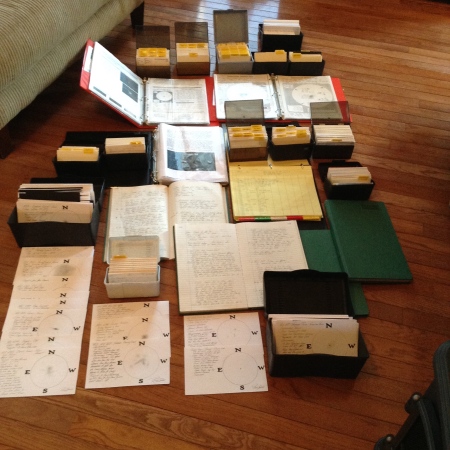The Importance of Documenting Observations For Future Reference
The following photo represents my past ~30 years of observing, documenting, sketching and articles. However, my first observations began in the mid to late sixties, but without notes or pencil sketches.

When I purchased my first serious telescope back in the mid-70’s, I also picked up a small astronomy reference book: “The Finest Deep-Sky Objects” by James Mullaney and Wallace McCall. It was a small paperback with 31 pages, filled with an incredible amount of information, the majority being double stars.
This book also contained a number of galaxies, nebulae, star clusters, and even included several prominent red stars. This would be my first list of objects to observe, and document.
My next list of objects to observe was the Messier catalog, which I’ve observed and documented multiple times, taking my time and being very patient.
This began my quest of making simple notes of all the objects I was observing. However, my notes were pretty poor, mostly listing only the identification number and object. However, I had to start somewhere, and this seems to be how many amateurs begin their documentation of observations….writing down nothing more than “I saw M37 and M42…etc.”
The late Tom Lorenzin, author of “1000+ The Amateur Astronomer’s Field Guide to Deep-Sky Observing” shared the same. This made me feel better, saying that he too, in his early days listed only the object identification, being the Messier number, NGC or IC.
In the early 90’s I began using “1000+” almost exclusively, at least for the following ten or more years. I really liked the descriptions by Lorenzin, being relatively brief, but saying so much. He was very effective with his use of words.
I was fortunate to have been able to meet Tom Lorenzin, on numerous occasions, and we became friends.
I patterned my descriptions to follow in Tom Lorenzin’s format…attempting to use as much precision as possible, but without being overly wordy.
My writing and observation notes both improved during this period, but I needed more than just notes. I started pencil sketching. It’s true…”a picture is worth a thousand words.”
It’s my opinion: visual observing is seeing the faintest of detail in each and every deep-sky object, then recording and/or sketching the object.
I continued to sketch and to-date have spent thousands of hours at the eyepiece, never wanting to be anything more than a visual backyard observer.
My only regret….I don’t have any notes or sketches from my earliest days. Those days at thirteen years old, with my brothers, 60 mm refractor, from the weedy field beside my childhood home, in the foothills of North Carolina.
Roger Ivester

I started observing in the mid-60’s at about 13 years of age, but it’s been only in the past 30 years that I’ve become a very serious student of amateur astronomy. Previous to that, I would just go outside, observe a few objects, and then come back into the house.
No notes, no sketches, no nothing. What a waste of good observing time and years!
I just wish I had some notes from my first observations of the Andromeda Galaxy, the Ring Nebula, and many other deep-sky objects which I managed to stumble across as a 13 year old, using my brothers 60 mm refractor.
I can close my eyes even now, and see that vacant field beside my house with the Milky Way seemingly visible from horizon to horizon. It was a great place for a young budding amateur astronomer to begin a lifelong trek into the depths of deep-space.
In the past I’ve made my sketches on 3 x 5 notecards, or larger scale 8.5 x 11 sketch pads. However, for the past ten years, my favorite is 5 x 8 blank note cards with a 3-inch circle drawn on the right side. It was Sue French who was using the 5 x 8 system, and gave me the idea to change.
It’s very important to me that my sketches be as accurate as possible, as seen through the eyepiece, without any embellishment. Roger Ivester
Blank 5 x 8 note cards with the colors inverted:







Explore posts in the same categories: Roger's Articles